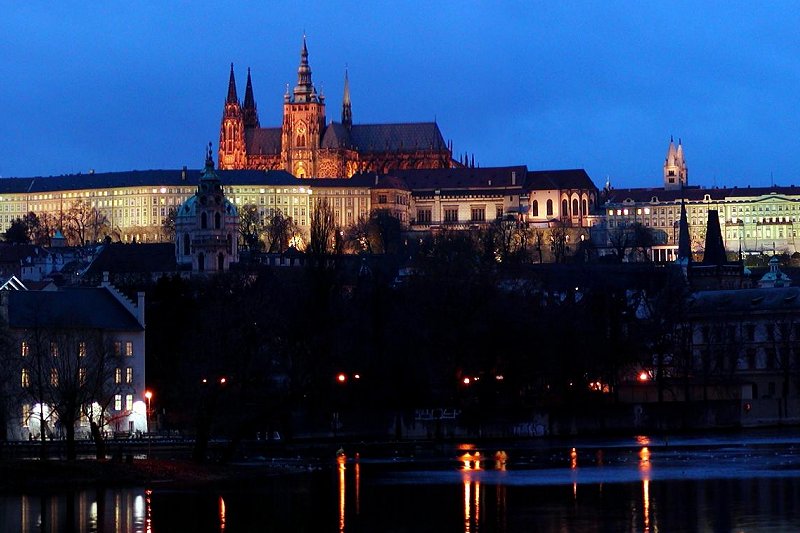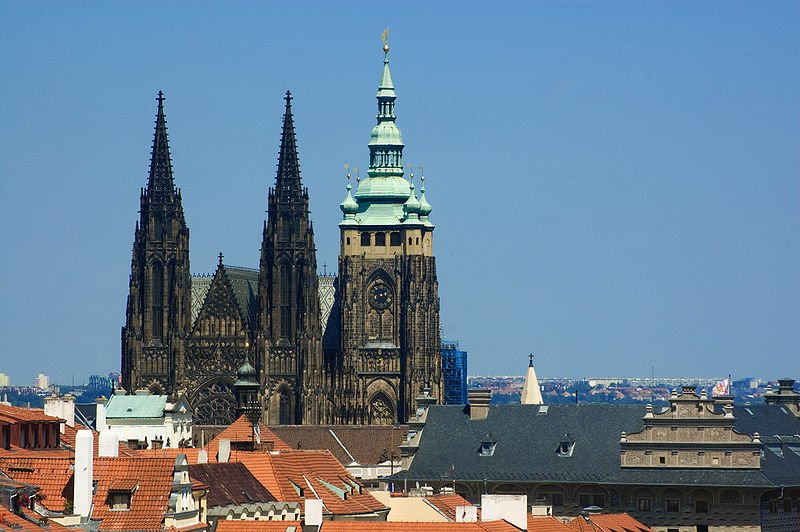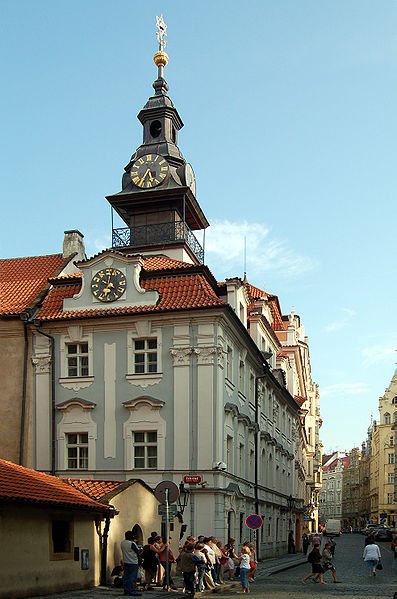
Prague (Praha), Czech Republic
 Go Back - HOME | Latest Czech Republic > Europe > World | YouTube : Facebook | About Me : Contact Me
Go Back - HOME | Latest Czech Republic > Europe > World | YouTube : Facebook | About Me : Contact Me Prague Castle at night
Prague Castle at nightAuthor: © Martin Hlauka
Source: https://commons.wikimedia.org/wiki/File:Hradcany_vecer_-_Praha.jpg
Prague (Praha) is the capital and biggest city in the Czech Republic. It covers 496 sq km on the northeastern part of the country. The city has a population of 1.3 million people (2011 estimate) within a metropolitan area of 2.3 million people.
 St Vitus Cathedral, Prague
St Vitus Cathedral, PragueSource: https://commons.wikimedia.org/wiki/File:StVitusCathedral-Prague-CZ-roofs-towers.jpg
Author: Aqwis

Prague is in the Central European Time zone, which is an hour ahead of Coordinated Universal Time (UTC+1) and two hours during Daylight Saving Time in summer. The city is the cultural, political and economic center of the Czech Republic, and one of the most influential cities of central Europe.
Prague experiences a borderline oceanic climate. The warmest months are July and August, when the average high temperature regularly exceeds 23°C (73.4°F). The coldest month is January, when the average low temperature drops to -5.4°C (22.3°F). Wettest month is May, with 77.2 mm (3 in) of precipitation, followed by June, with 72.7 mm (2.86 in).
 Nekázanka Street in Prague New Town
Nekázanka Street in Prague New TownSource: https://commons.wikimedia.org/wiki/File:Nek%C3%A1zanka,_mostn%C3%AD_p%C5%99echody,_%C4%8CEDOK.jpg
Author: ŠJů

The history of Prague goes back to the Paleolithic Age. The Celts were the earliest to live in the area, establishing their settlement here around 200 BC. Different peoples were to migrate into the area in the subsequent centuries, among them Germanic and West Slavic tribes.
Prague Castle, one of the oldest structures in the city, dates from AD 885. The St Vitus Cathedral, located within the grounds of Prague Castle, was built in AD 1344, but was only completed in the 20th century. Prague was a made a bishopric AD 973, within the Archbishopic of Mainz, until 1344, when it was elevated to an archbishopric.
 Jewish Town Hall, Prague
Jewish Town Hall, PragueSource: https://commons.wikimedia.org/wiki/File:Jewish_tawnhall_%28Prague%29.jpg
Author: Martin Pauer

As a trading center in Central Europe, Prague had a substantial Jewish population for over a thousand years. The Old New Synagogue of Prague is one of the oldest synagogues still standing in the world, dating to AD 1270.
Prague reached its Golden Age under the reign of Charles IV, the Holy Roman Emperor and King of Bohemia, who ruled from Prague from 1346 to 1378. Many of the historic buildings of Prague dates from his reign, among them the Charles Bridge, Charles University (oldest university in Central Europe) and St Vitus Cathedral.
The 16th and 17th centuries were turbulent times for Prague and Bohemia, as the kingdom was often at war with its neighbors. In 1689, Prague was destroyed by a big fire. Then in 1713, it was hit by a plague killing thousands of its inhabitants. However the end of the 17th century brought better fortunes to the city, and its wealthy merchants and nobles were soon building opulent homes, palaces, churches and gardens in the city, making the Baroque architectural style renowned across Europe.
 Vlado Milunič & Frank Gehry's Dancing House, Prague
Vlado Milunič & Frank Gehry's Dancing House, PragueSource: https://en.wikipedia.org/wiki/File:PG07ME957_edit.jpg
Author: Matteo Piotto

The First World War brought an end to the Austro-Hungarian Empire and the creation of Czechoslovakia, with Prague as its capital. The Nazis invaded Czechoslovakia on 15 March 1939, and made Bohemia and Moravia a German protectorate. It was a period of persecution directed mainly at the Jewish population, many of whom managed to flee the city.
After the Second World War, Prague finds itself behind the Iron Curtain. A period of liberalization known as the Prague Spring, which began on 5 January 1968, came to a brutal end with the Soviet Union invaded Czechoslovakia on 21 August. True liberalization only came many decades later, with the collapse of the Soviet Union in the Velvet Revolution of 1989. In 1993, Czechoslovakia peacefully split into two countries, with Prague being made the capital of the new Czech Republic.
 Střížkov Metro Station, Prague
Střížkov Metro Station, PragueSource: https://commons.wikimedia.org/wiki/File:Metro_St%C5%99%C3%AD%C5%BEkov_4.jpg
Author: Karelj

Visiting Prague
The Ruzyně International Airport, located 20 km to the northwest of downtown Prague, is the main international gateway. Arriving at the airport, you can take a bus to the city. Tickets can be purchased from the counter or vending machines at the Arrival Hall. Bus 119 goes to the Dejvická subway station for Metro A while bus 100 takes you to the Zličín subway station for Metro B.Exploring Prague
Within the historical quarters, the best way to see Prague is on foot. However, the streets are cobbled, and in places go uphill and down steeply, so you need good walking shoes. To cover greater distances, take the subway or the trams. 24-hour tickets are available for 100 CZK.Places of Interest in Prague, Czech Republic
- Astronomical Clock
- Charles Bridge
- Church of Saints Cyril and Methodius
- Dancing House
- Lennon Wall
- Metronome
- Mucha Museum
- Museum of Decorative Arts
- National Museum
- New Jewish Cemetery
- Old Jewish Cemetery
- Old New Synagogue
- Prague Castle
- Prague Zoo
- Vinohrady
- Vy
Neighborhoods of Prague
- Anděl
- Hradčany
- Josefov (Jewish Quarter)
- Malá Strana (Lesser Town)
- Nové Město (New Town)
- Petřínská rozhledna
- Písek Gate
- Staré Město (Old Town)
- Vyšehrad Castle & Cemetery
 Latest updates on Penang Travel Tips
Latest updates on Penang Travel Tips

Copyright © 2003-2025 Timothy Tye. All Rights Reserved.